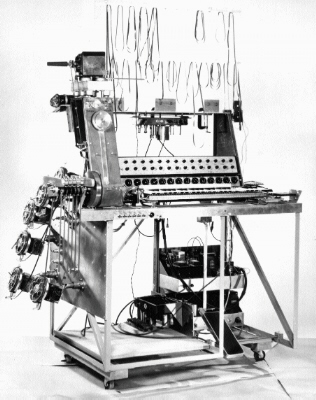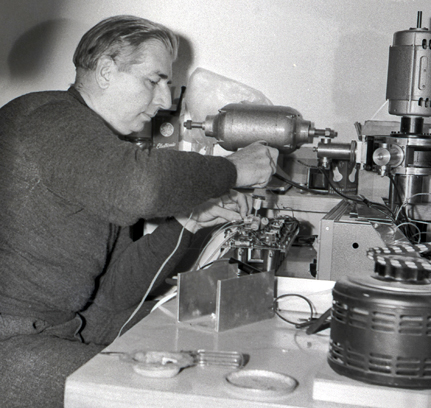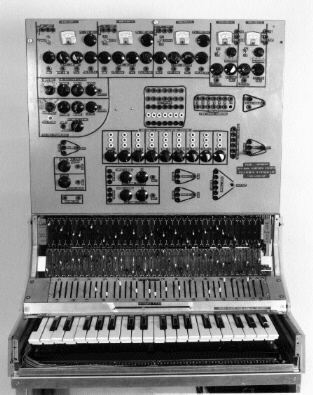App installieren
So wird die App in iOS installiert
Folge dem Video um zu sehen, wie unsere Website als Web-App auf dem Startbildschirm installiert werden kann.
Anmerkung: This feature may not be available in some browsers.
Du verwendest einen veralteten Browser. Es ist möglich, dass diese oder andere Websites nicht korrekt angezeigt werden.
Du solltest ein Upgrade durchführen oder einen alternativen Browser verwenden.
Du solltest ein Upgrade durchführen oder einen alternativen Browser verwenden.
swissdoc
back on duty
Buch und CD sei jedem empfohlen, der sich für History of Synths interessiert. Gute Lektüre.
http://www.hughlecaine.com/en/publications.html
http://www.hughlecaine.com/en/publications.html
oli
*****
Ja, wow, den Hugh le Caine kannte ich noch nicht.
Was für heisse Instrumente er entwickelt hat!
Eben darüber im Netz gestolpert:
"This 1957 photograph of the prototype Special Purpose Tape Recorder shows the six reels of tape playing simultaneously, the keyboard with which the playback speed was controlled, and a series of tape loops hanging above the instrument."

https://youtu.be/zvHSvSBwFYM
Was für heisse Instrumente er entwickelt hat!
Eben darüber im Netz gestolpert:
"This 1957 photograph of the prototype Special Purpose Tape Recorder shows the six reels of tape playing simultaneously, the keyboard with which the playback speed was controlled, and a series of tape loops hanging above the instrument."

https://youtu.be/zvHSvSBwFYM
oli
*****
Zu dem verlinkten Stück "Dripsody":
"Though his composition output was small, Le Caine is remembered as one of the great pioneer composers of musique concrète, his best known work being Dripsody (1955), a piece of musique concrète based on the sound of a single drop of water that over the course of the piece is permuted and contorted into a variety of sounds. Le Caine used a metal wastebasket filled with two inches of water, held an eyedropper ten inches above the wastebasket, and tape-recorded the water drops for thirty minutes. After reviewing the resulting recording, Le Caine selected one of the water drops and spliced it onto a short tape loop. This allowed the water drop to repeat like a traditional ostinato figure.
Le Caine wrote down rhythmic figures he felt stimulated the sound of water drops then he decided how loud to make each figure, writing down a corresponding decibel number. He correlated the time values of the rhythms with different lengths of tape. Coming back to the tape recorder, Le Caine used that new tool to perform five kinds of operations or manipulations, all with a different effect.
The first operation, which was the changing of tape speed, was his primary technique. The faster the tape is played, the higher the pitch and vice versa. Tape speed is measured by ips or inches per second. So slowing a recording by half (7-1/2-ips), lowers all pitches by an octave. Le Caine created a three-octave keyboard that allows him to choose different speeds. All the different pitches during Dripsody were achieved by changing the tape speed. He, sometime in the process of creating the keyboard, assembled the pitches into a pentatonic (five note) scale pattern.
The second operation's objective was to play the recorded sound backwards, reversing the direction of the tape. Acoustically, the effect is to change the amplitude envelope. What we normally experience with amplitude is, for example, pressing a key on a piano, a loud sound emerges then slowly fades away; the second operation's objective is the opposite.
Le Caine also used four different tape loops to produce ostinato patterns heard in Dripsody. Three different speeds creates twelve different loops not needing to add additional splices. However, he did use splices as his fourth operation. Splicing different pitches resulted from different playback speeds of initial drop creates a twelve-note arpeggio. Only twenty-five splices were used to compose the piece, which made him very proud, and the multi-track recorder controlled all other variations.
The fifth operation was the use of tape delay, not to be confused with the same term used on the television world that means to postpone broadcasts. To Le Caine, it was an echo effect he produced by playing a sound on the recorder while re-recording the sound at the same time. The new recording had a lower amplitude and created an echo-like sound."
Le Caine spent one night manipulating his initial "drop" sound. The overall work could be considered programmatic, it is similar to the ebb and flow of a rain shower. There are various versions since he added a stereo mixing system to the multi-track. Dripsody is one of the most frequently played examples of musique concrète, but Le Caine remained modest. Once when asked why he chose the name Dripsody he replied, "Because it was written by a drip."

 en.m.wikipedia.org
en.m.wikipedia.org
"Though his composition output was small, Le Caine is remembered as one of the great pioneer composers of musique concrète, his best known work being Dripsody (1955), a piece of musique concrète based on the sound of a single drop of water that over the course of the piece is permuted and contorted into a variety of sounds. Le Caine used a metal wastebasket filled with two inches of water, held an eyedropper ten inches above the wastebasket, and tape-recorded the water drops for thirty minutes. After reviewing the resulting recording, Le Caine selected one of the water drops and spliced it onto a short tape loop. This allowed the water drop to repeat like a traditional ostinato figure.
Le Caine wrote down rhythmic figures he felt stimulated the sound of water drops then he decided how loud to make each figure, writing down a corresponding decibel number. He correlated the time values of the rhythms with different lengths of tape. Coming back to the tape recorder, Le Caine used that new tool to perform five kinds of operations or manipulations, all with a different effect.
The first operation, which was the changing of tape speed, was his primary technique. The faster the tape is played, the higher the pitch and vice versa. Tape speed is measured by ips or inches per second. So slowing a recording by half (7-1/2-ips), lowers all pitches by an octave. Le Caine created a three-octave keyboard that allows him to choose different speeds. All the different pitches during Dripsody were achieved by changing the tape speed. He, sometime in the process of creating the keyboard, assembled the pitches into a pentatonic (five note) scale pattern.
The second operation's objective was to play the recorded sound backwards, reversing the direction of the tape. Acoustically, the effect is to change the amplitude envelope. What we normally experience with amplitude is, for example, pressing a key on a piano, a loud sound emerges then slowly fades away; the second operation's objective is the opposite.
Le Caine also used four different tape loops to produce ostinato patterns heard in Dripsody. Three different speeds creates twelve different loops not needing to add additional splices. However, he did use splices as his fourth operation. Splicing different pitches resulted from different playback speeds of initial drop creates a twelve-note arpeggio. Only twenty-five splices were used to compose the piece, which made him very proud, and the multi-track recorder controlled all other variations.
The fifth operation was the use of tape delay, not to be confused with the same term used on the television world that means to postpone broadcasts. To Le Caine, it was an echo effect he produced by playing a sound on the recorder while re-recording the sound at the same time. The new recording had a lower amplitude and created an echo-like sound."
Le Caine spent one night manipulating his initial "drop" sound. The overall work could be considered programmatic, it is similar to the ebb and flow of a rain shower. There are various versions since he added a stereo mixing system to the multi-track. Dripsody is one of the most frequently played examples of musique concrète, but Le Caine remained modest. Once when asked why he chose the name Dripsody he replied, "Because it was written by a drip."

Hugh Le Caine - Wikipedia
News
-
Knobula Pianophonic - Ein Piano für Leute die keine Pianos brauchen - Eurorack + MIDI!
- Gestartet von Moogulator
- Antworten: 1
-
9-11.5.2024, Fischbach bei Idar Oberstein, Modular Meeting Happy Knobbing 2024
- Gestartet von Moogulator
- Antworten: 0
-
-
-
-
Samples! Von der Verwaltung bis zum Einsatz - SequencerTalk 204
- Gestartet von Moogulator
- Antworten: 1
-
